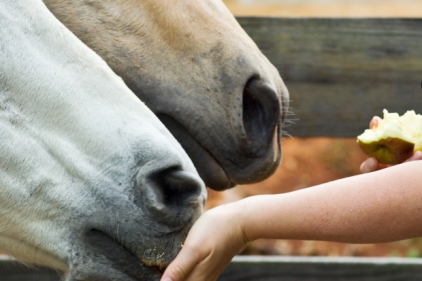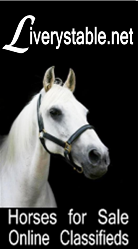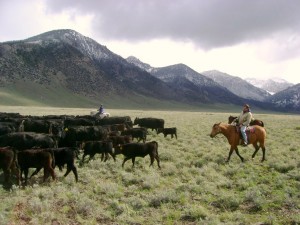 It’s been awhile since I’ve worked cattle on horseback (well, almost a year to be exact!), but I used to do it every day when I was a teenager. I learned so much about cattle when I was working alongside my dad. His approach to working cattle was very practical and methodical; my dad is a very patient individual. But he never really explained things—he expected us to know what he was thinking, to understand what the cattle were going to do before they did it, and to be exactly in the right place to control them at all times. Anything less was just unacceptable, and he would just be baffled when we fell short of his expectations. I wish he had given us kids a few basic rules from the beginning, so this article is an attempt to do just that: guidelines for handling cattle for the beginner.
It’s been awhile since I’ve worked cattle on horseback (well, almost a year to be exact!), but I used to do it every day when I was a teenager. I learned so much about cattle when I was working alongside my dad. His approach to working cattle was very practical and methodical; my dad is a very patient individual. But he never really explained things—he expected us to know what he was thinking, to understand what the cattle were going to do before they did it, and to be exactly in the right place to control them at all times. Anything less was just unacceptable, and he would just be baffled when we fell short of his expectations. I wish he had given us kids a few basic rules from the beginning, so this article is an attempt to do just that: guidelines for handling cattle for the beginner.
Reliving the day of the round up still puts butterflies in my stomach. I remember being five years old and climbing into the pickup to go out and start a day’s work, and being so excited that I got to go along I would actually get a tummy ache. When we got to the pasture the cattle were in, we would unload the horses from the trailer and mount up. Riders would split into different directions, with the common knowledge of where the gathering point would be—either the windmill where the cattle watered, or a gate where we would move the cattle through to begin the cattle drive. Then we would ride through the hills, gathering the scattered grazing cattle into small bunches and moving them along as we swept through the pasture, bringing them all to the gathering point.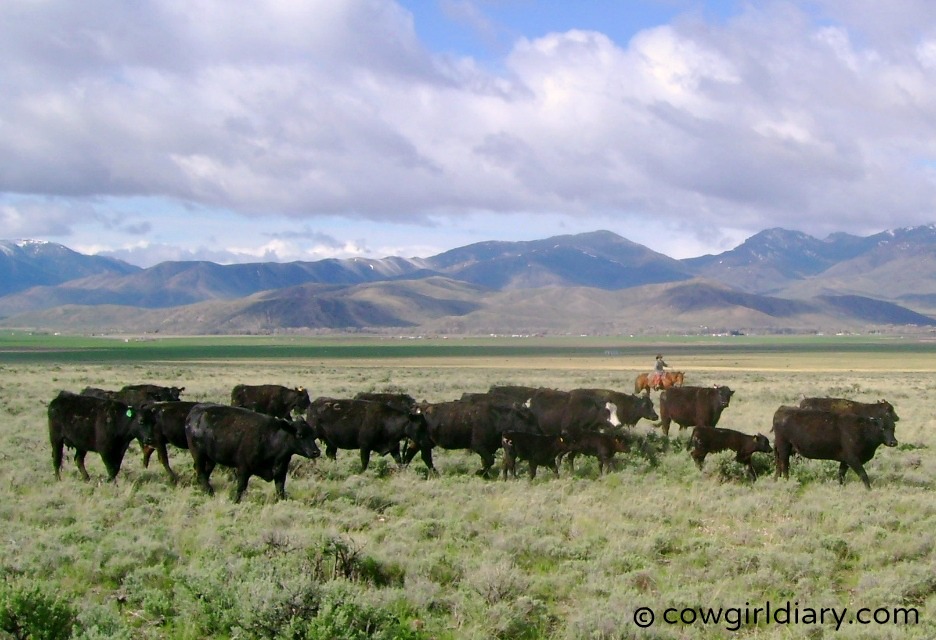
The first rule of cattle work was to be quiet. There is nothing worse than riding towards a herd of cattle and seeing them stand up from their sleeping or look up from grazing, throw their heads in the air and run for the four corners of the earth. Cattle are better when handled calmly, and to achieve that, you work quietly around them and don’t scare them unnecessarily. We had neighbors whose cattle were very skittish, and it was nearly impossible to work them. For instance, if one of our cows got in with the neighbors, it was much harder to ride into their pasture and retrieve our cow, because their whole herd would jump and run at the sight of a horse and rider. Dad’s cattle are all used to being handled horseback, and they’re used to people being pretty quiet and calm around them.
The second rule is like unto the first: don’t run the cattle. Most of our cattle work involved driving the herd for ten miles at a time or more, so you needed the cattle to maintain their energy and have enough endurance to make the trip safely. On hot days, if cows get overheated, they will fall down and not be able to move, or even die. Cows are scientifically unable to sweat; they do not cool off very well if they’re in constant motion, so on cattle drives, you have to let them go slowly.
Now, occasionally, there would be reasons for speed. If a cow started to turn back the wrong way, it was very important to stop her immediately. Cows are very stubborn creatures and will get something in their head and it’s very difficult to change their minds. I remember last time we drove cattle up Pass Creek to the mountain ranges near my folks’ place, we got ten miles up the valley and one cow decided her calf was not in the herd and she was going to go back and find him. She didn’t know that her calf had tired out and been put in the trailer, and that he was following the herd riding leisurely along. She thought he was back where she had fed him last. So down the mountain she went, at a run, and three of us tried to stop her (in my defense, I was riding a three year old filly who had never been on a cattle drive before), and she blew past us like a bowling ball past the pins! My dad was after her on his gelding Red, but it was pretty clear there was no stopping her after the first few attempts. So he took her several miles down the road to a corral where he got her confined and loaded up in the trailer with her calf. 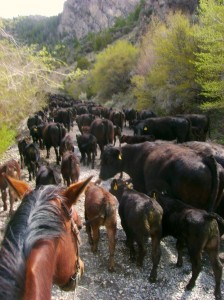
Another very important rule in driving cattle is to not turn back animals on the outskirts of the herd. When riding a horse with little or no cow experience, it’s hard to maintain the slow and steady pace equivalent to a walking cow. Most horses walk faster, and the rider must stay alert and either slow his horse or ride along the sides of the herd so as to not pass up cattle and discourage them from following along with the herd. When I was riding a colt, I didn’t want to constantly be in his mouth (pulling back on the reins) to slow him down. So I would let him walk fast, but every little while I would ask for a complete turn, left or right, or even a whoa. This would not only keep us at the back of the cow herd, it would also hone the colt’s skills in turning and standing still, which are both very necessary skills for a young horse. You just can’t be passing up the calves or slower cows at the back of the herd, because what a calf is going to do when you ride by it is stop, stare at you, and turn back to run home and look for his mama. So a rider that’s constantly moving too fast and passing cattle is not going to be much help on a cattle drive. Stay behind the cattle.
Another good rule is to be alert to potential problems. A top hand will see trouble before it starts, and my dad was always really good at this. For instance, if you’re driving cattle down a dirt road and there is a farmhouse up ahead, you’re going to want to put a few riders up ahead in the open driveways to block off cattle from turning in and grazing the people’s yard. Cows will take any available opening to slow down and eat, so think ahead and have riders hurry ahead of the herd to block them from diverting from the desired route.
Another tip with working cattle is to understand the benefit of noise and know when to use it. At the beginning of a cattle drive, you may need to be very quiet to keep the herd from running. We have even had to keep riders at the front of the herd to slow down the lead cows, as many times a lead cow will think, “Spring grass! Everybody hurry!” and take off down the road. So it would not be smart for those at the back of the herd to be yelling and whooping at that time. However, a few hours into the drive, you’re going to have lagging calves and older cows getting really slow. You can either stop and wait for them or you can start working on them to hurry them up. This is where noise comes in. My favorite urging sound for baby calves is a “ch-ch-ch” sound, as it is foreign to them, and therefore scary, but doesn’t carry very far to frighten the lead animals. If you make a spooky sound at a lagging calf, it’s going to wake him up and get him trotting up beside his mother where he feels safer…and he will travel faster walking beside his mother than lagging along at the back of the herd. I also like to whistle when driving cows, I think that’s actually how I first learned to whistle.
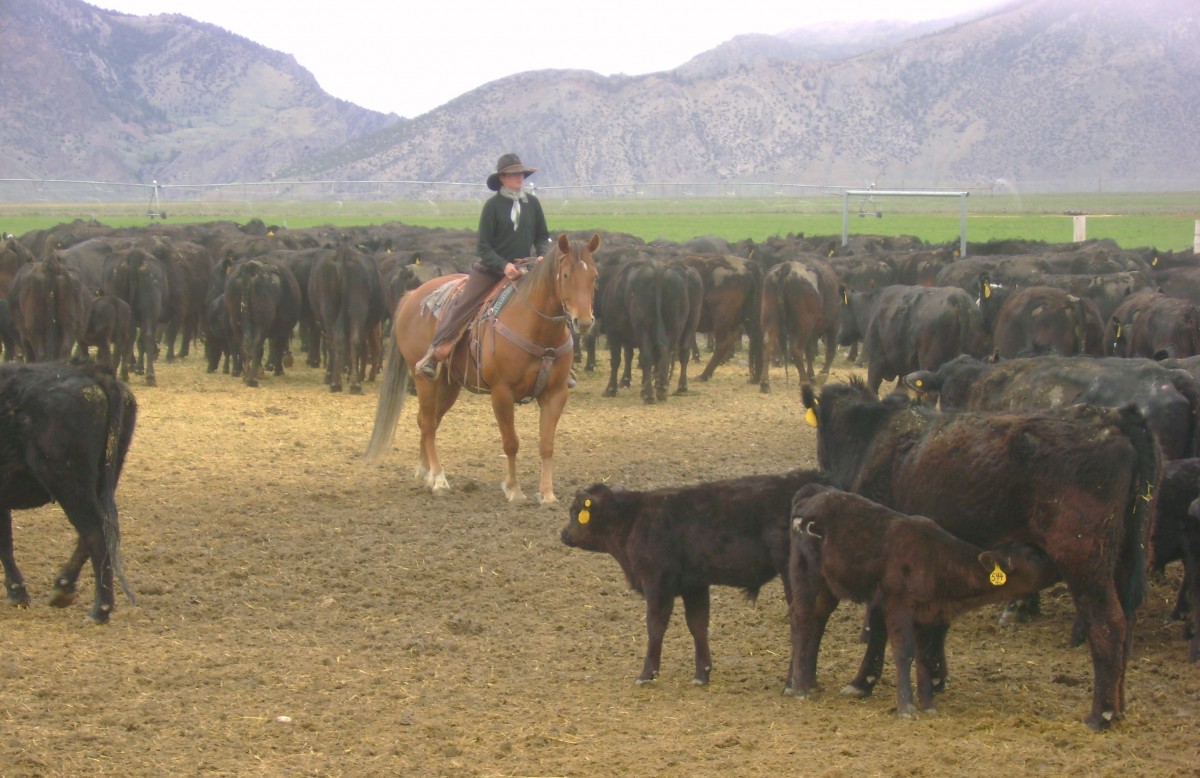
Perhaps the best advice of all is to make things easy for the cows. If cows are used to being fed their hay daily by a tractor, they associate the tractor with good things and will follow it happily wherever it goes. So make things easier and have someone drive the tractor with a hay bale on the back leading the herd. It will show the cows the way to go and keep them from running ahead. It might not be the “cowboy” way to do things, but it sure saves a lot of trouble. I always think that luring a cow is easier than driving one.
Those are just a few tips for beginning cowhands. Spending time around cattle will help give you a better understanding of how they think.
